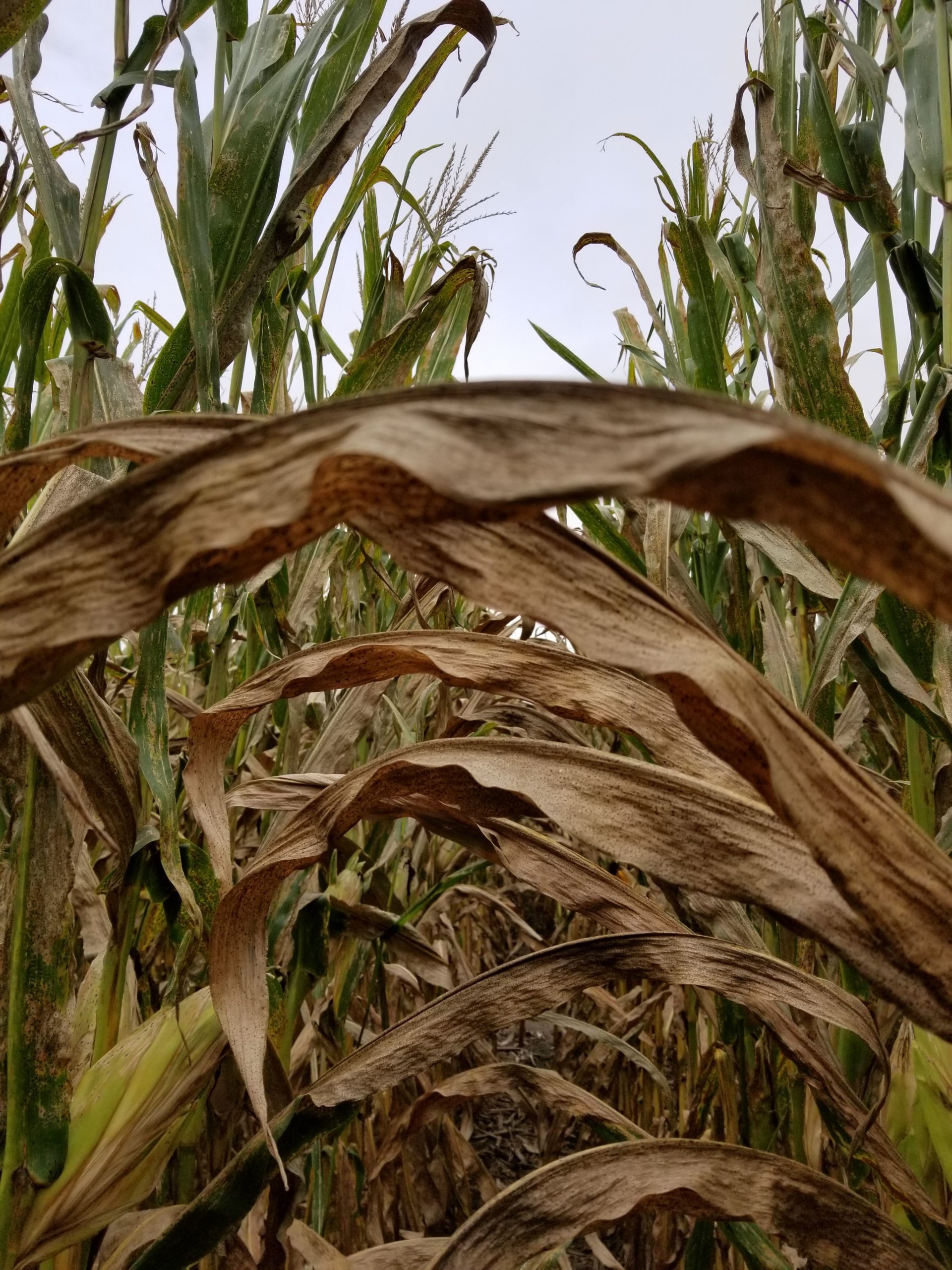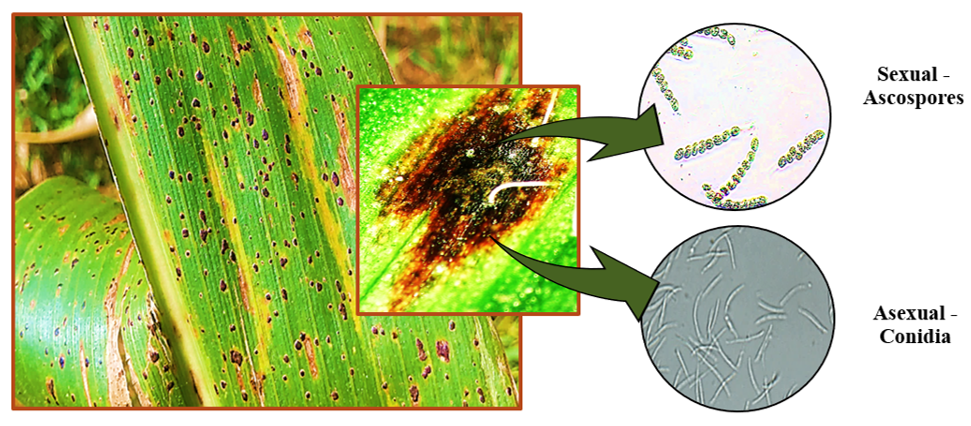Characterizing the Distribution, Biology, and Management of Corn Tar Spot to Reduce Its Impact in Indiana
The 2018 season saw an outbreak of a relatively new foliar disease of corn in Indiana: tar spot. This disease was first detected in the United States in 2015 in both Indiana and Illinois. Since its discovery, it has also been confirmed in 14 states and Ontario, Canada. Initially, tar spot was found in seven counties in Indiana in 2015. As of November 1 of 2021, it has been confirmed in 82 counties in Indiana based on state-wide survey and samples sent in for confirmation. Localized epidemics were quite severe in a number of counties in Northern Indiana and in pockets in southwestern Indiana in 2021. Since 2018, it is estimated that tar spot has led to a loss of over 60 million bushels ($235 million) in Indiana; with a 240 million bu loss ($895 million) in the U.S (Crop Protection Network). Unfortunately, there has been limited information on the biology of the pathogen(s) that causes tar spot, as well as the epidemiology and management of this disease, since it was not found in the United States or North America until 2015 and did not cause yield losses until the 2018 epidemic. Initial models show 3-8 bu loss for every 10% increase in tar spot. Observations this season also noted that tar spot may also increase crop susceptibility to other foliar diseases and stalk rots.
Research shows that fungicide application before the disease becomes severe in the canopy may provide significant yield protection. In addition, the statewide field survey has allowed for the development of maps that demonstrate future areas of greatest risk for tar spot and regions where tar spot may impact corn production in Indiana.
Efforts contributed to new knowledge, tools, and practices to address tar spot, and continue to quickly and effectively distribute information and results for increased understanding of management options for corn growers. The ultimate goal of this research will be to improve our understanding of the biology and epidemiology of this new disease and provide Indiana farmers with valuable information on how to manage tar spot disease in corn.
The results from applied research trials on tar spot can be found in the Applied Research in Field Crop Pathology Publications and links below.
Publications:
Telenko, D. E. P., Chilvers, M. I., Ames, K., Byrne, A. M., Check, J. C., Da Silva†, C. R., Ross†, T. J., Smith, D. L., and Tenuta, A. 2022. Fungicide efficacy during a severe epidemic of tar spot on corn in the United States and Canada. Plant Health Progress. doi.org/10.1094/PHP-02-22-0012-BR.
Broders, K., Iriarte-Broders, G., Bergstrom, G. C., Byamukama, E., Chilvers, M., Cruz, C., Dalla Lana, F., Duray, Z., Malvick, D., Mueller, D., Paul, P., Plewa, D., Raid, R., Robertson, A. E., Salgado-Salazar, C., Smith, D., Telenko, D., VanEtten, K., and Kleczewski, N. M. 2022. Phyllachora species infecting maize and other grass species in the Americas represents a complex of closely related species. Ecology and Evolution.12:e8832. doi.org/10.1002/ece3.8832.
Telenko, D. E. P., Chilvers, M. I., Byrne, A. M., Check, J. C., Da Silva, C. R.‡, Kleczewski, N. M., Roggenkamp, E., Ross, T. J.†, and Smith, D. M. 2022. Fungicide efficacy on tar spot and yield of corn in the Midwest. Plant Health Progress. doi.org/10.1094/PHP-10-21-0125-RS.
Shim, S. and Telenko, D. 2022. Applied Research in Field Crop Pathology for Indiana 2021. Jan 2022. Purdue Extension.BP-217-W.
Lipps, S., Smith, D., Telenko, D., Paul, P., Kleczewski, N., Jamann, T. 2022. Identification of Resistance for Phyllachora maydis of Maize in Exotic-Derived Germplasm. Crop Science. doi.org/10.1002/csc2.20709.
Da Silva, C. R.‡, Check, J., MacCready, J. S., Alakonya, A. E., Beiriger, R., Bissonnette, K. M., Collins, A., Cruz, C. D., Esker, P. D., Goodwin, S. B., Malvick, D., Mueller, D. S., Paul, P., Raid, R., Robertson, A. E., Roggenkamp, E., Ross, T. J. †, Singh, R., Smith, D. L., Tenuta, A. U., Chilvers, M. I., and Telenko, D. E. P. 2021. Recovery Plan for Tar Spot of Corn, Caused by Phyllachora maydis. Plant Health Progress. doi.org/10.1094/PHP-04-21-0074-RP.
Telenko, D., Chilvers, M., Kleczewski, N., Mueller, D., Plewa, D., Robertson, A., Smith, D., Sisson, A., Tenuta, A., and Wise, K., 2021. Tar Spot of Corn. Crop Protection Network. CPN 2015. doi.org/10.31274/cpn-20201214-2.
Telenko, D. E. P., Ross†, T., Shim, S., Wang, Q., and Singh, R. 2020. Draft genome sequence resource for Phyllachora maydis - an obligate pathogen that causes tar spot of corn with recent economic impacts in the United States. MPMI 2020 Apr 1. https://doi.org/10.1094/MPMI-03-20-0075-A.
Valle-Torres, J., Ross†, T. J., Plewa, D., Avellandea, M. C., Check, J., Chilvers, M. I., Cruz, A. P., Dalla Lana, F., Groves, C., Gongora-Canul, D., Henriquez-Dole, L., Jamman, T., Klewczewski, N., Lipps, S., Malvick, D., McCoy, A. G., Mueller, D. S., Pual, P. A., Puerto, C., Schloemer, C., Raid, R. N., Robertson, A., Roggenkamp, E. M., Smith, D. L., Telenko, D. E. P., and Cruz, C. D. 2020. Tar spot: an understudied disease threatening corn production in the Americas. Plant Disease. doi/abs/10.1094/PDIS-02-20-0449-FE
Groves, C.L., Kleczewski, N.M., Telenko, D.E.P., Chilvers, M.I., and Smith, D.L., 2020. Phyllachora maydis ascospore release and germination from overwintered corn residue. Plant Health Progress 21:26-30. https://doi.org/10.1094/PHP-10-19-0077-RS
Mueller, D.S., Wise, K.A., Sisson, A.J., Allen, T.W., Bergstrom, G.C., Bissonnette, K.M., Bradley, C.A., Byamukama, E., Chilvers, M.I., Collins, A.A., Esker, P.D., Faske, T.R., Friskop, A.J., Hagan, A.K., Heiniger, R.W., Hollier, C.A., Isakeit, T., Jackson-Ziems, T.A., Jardine, D.J., Kelly, H.M., Kleczewski, N.M., Koehler, A.M., Koenning, S.R., Malvick, D.K., Mehl, H.L., Meyer, R.F., Paul, P.A., Peltier, A.J., Price, P.P., Robertson, A.E., Roth, G.W., Sikora, E.J., Smith, D.L., Tande, C.A., Telenko, D. E. P., Tenuta, A.U., Thiessen, L.D., and Wiebold, W.J. 2020. Corn yield loss estimates due to diseases in the United States and Ontario, Canada, from 2016 to 2019. Plant Health Progress. doi.org/10.1094/PHP-05-20-0038-RS
†AUTHOR NOTED WITH † is/was a graduate student in Dr. Telenko's program.
Research supported by:











